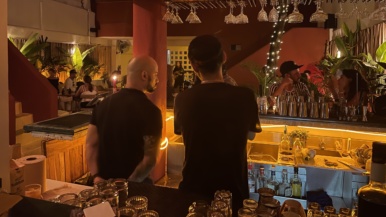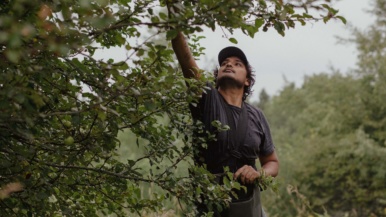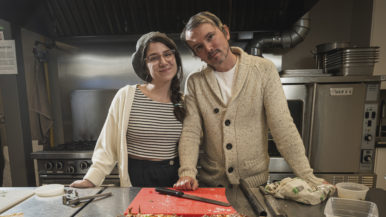My beautiful death
I spent 15 years sanding and grinding mussel shells to create my sculptures. Then I was diagnosed with heavy-metal poisoning

When you’re an artist, the work often becomes more important than you. Sadly, that’s always been the case for me. I started sculpting in 1991, working only with natural materials. At first, I sold small sculptures made of eggshells at the One of a Kind Show. Later, I created larger pieces modelled after the human anatomy using bones, coral and dried plants. My studio housed a collection of dead things.
In 1998, I finished a sculpture of Lilith—the first woman, according to Jewish folklore—made from eggshells. I began using blue mussel shells to create her counterpart: Adam, the first man. The shells came from Atlantic Canada, and I’d buy them in bulk in Chinatown, so that I could sort through the bins and choose shells in the shapes I wanted.

I spent up to 12 hours a day grinding and sanding the shells to fit into the shape of Adam’s body. They beautifully replicated the striations in his muscle fibres. I sifted through thousands of mussels and served them to friends and family two or three times a week.
After a few months working on Adam, I began to feel unwell. I was agitated all of the time. I had constant headaches, and I vomited often, sometimes a few times a day. I visited a never-ending assortment of specialists—neurologists, rheumatologists, endocrinologists—hoping to figure out what was wrong with me. When they asked me if I worked with anything toxic, I said no, that I only used natural materials.

The symptoms worsened. After a few hours of grinding mussel shells, I would become immobilized. My muscles ached. My hands would cramp when I held my tools. I became combative and fatalistic, declaring that my life was over. My husband was afraid to the leave the house, worried he’d come home and find me hanging from the chandelier. He found friends to babysit me. These symptoms continued, on and off, for 15 years.
One day in 2013, I cleaned out my ventilation system, which had trapped years of fine dust. As I swept out the particles, I suddenly felt weak and unable to stand. For the next week, I lay in bed, my mind in a fog. I couldn’t string full sentences together, and my speech was slurred. My whole body was in excruciating, paralyzing pain—my neck, abdomen, arms—and I had suddenly lost all hearing in my left ear.

My hearing didn’t return after that, and my short-term memory became badly impaired. I developed spatial disorientation, confusing up with down, right with left. I couldn’t recognize people I had known most of my life. At the peak of my mental distress, I would walk up and down the street, muttering and shouting profanities to no one in particular. I saw a psychiatrist, but he had no idea why I was so erratic. We tried everything: antidepressants, antipsychotics, tranquilizers. Nothing helped. Painfully aware of my deteriorating mental health, I began to withdraw from the world.
It was nearly impossible to create art in this state. My brain was no longer capable of conjuring up anything except anger and misery. But I believed I was dying, and I wanted to finish the sculpture of Adam before I was gone. I had no idea he was the thing that was killing me.
One day, I visited the ROM, where I met a curator of invertebrates. He mentioned that bones and shells accumulate toxins in their environment. Upon further research, I discovered that common blue mussels are filter feeders. They pump several litres of water per hour and concentrate chemicals in their tissues. In some countries, mussels are used to read toxicity levels in the water. Suddenly, everything clicked into place.

In 2015, I was diagnosed with heavy-metal poisoning. Doctors found high levels of arsenic and lead in my blood, the result of chronic exposure. The water where the mussels grew was likely contaminated from industrial waste, and the mussel shells I’d been working with for decades were toxic. Metals can be absorbed through consumption, air or skin. I’d been exposed in every way.
When you make art, you often feel diminished and small—you’re just a vessel for the creative energy to pass through. My body was carrying a painful message about the poisoning that Earth is experiencing. Each of my sculptures has precious metal and stones embedded in them; all too often, treasure is defined by its scarcity. But the real treasures aren’t jewels and silver. They’re the creatures being eliminated, the beauty that’s disappearing.
I will never fully recover, and I continue to live with many neurological and metabolic symptoms. I have difficulty holding a thought. I’ll pick up a tool to work on a piece and forget why I chose it. I struggle with autoimmune disorders, and there are many foods I can’t eat without becoming ill. I’m at a high risk for developing Alzheimer’s or Parkinson’s. Heavy metals have an affinity for the tissues of the nervous system, particularly the ones in the brain.
I’m now 59 years old, and my quality of life is poor. But while I continue to work, even though it’s more difficult every day, I feel a terrible sadness. When we talk about environmental damage, we speak of declines in populations. Numbers and species. But I’ve experienced the suffering of so many creatures trapped in their polluted habitats. I now hope their voices can be heard—that my art might create a sense of awe, a sense of connectivity and reverence for the natural world.

I completed Adam in 2015. If I had left him unfinished, this all would have been for nothing. I often think of Beethoven, who suffered from lead poisoning; he lost his hearing and producing his work became an angry struggle. In the end, he had to create his music from the memory of sound. I was creating my art from the memory of joy. When I look at Adam, I feel grief—both for myself and our planet. But I also feel satisfaction because he is magnificent. That’s how I find my hope. I call him my beautiful death.
Gillian Genser is a sculptor in Toronto.
Email submissions to memoir@torontolife.com





